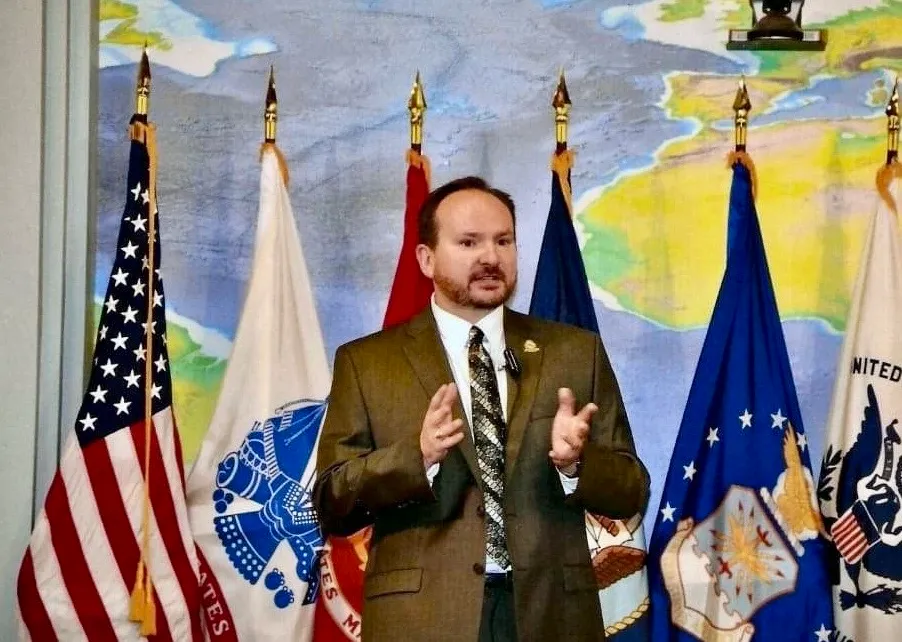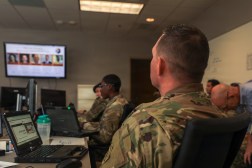‘One-two punch’: Inside NGA’s approach to exploring powerful next-gen AI

Analysts and technologists at the U.S. government’s top mapping agency are starting to cautiously experiment with emerging large language models and other disruptive generative AI capabilities to enhance their production of assets that inform military operations, according to a senior official leading that work.
In an interview with DefenseScoop this week, the National Geospatial-Intelligence Agency’s new and first-ever Chief AI Officer Mark Munsell shared initial details about one ongoing pursuit to train a cutting-edge model and shed light on his approach to steering NGA’s early adoption of the still-uncertain technology.
“We could not have predicted some of these inventions with transformers, like [generative pre-trained transformer or GPT] and stuff, and because of that and the trajectory of those, I think certainly we’re going to be living in a better world. But for the first time, we’ll have to really guard against misuse,” Munsell said.
As the CAIO suggested, genAI, geoAI and associated frontier models are part of a rapidly evolving field of technologies that are not fully understood, but are pushing the boundaries of what existing AI and machine learning can accomplish. Typically, such tech can process massive volumes of data and perform increasingly “intelligent” tasks like recognizing speech or generating human-like media and code when prompted.
These capabilities hold a lot of promise to dramatically enhance how the agency’s analysts detect and make sense of objects and activities they are tracking across sprawling data sources, inside NGA’s world that revolves around capturing and deciphering geospatial intelligence about movements and happenings all around the globe.
Munsell is expressly determined in his early months as the new AI chief to set the agency on a clear path for responsibly exploring and adopting powerful frontier models in their day-to-day operations.
However, one immediate challenge he said his team is confronting has to do with the fact that the major companies developing these next-generation models to date have not prioritized geographic use cases that would impact NGA’s work.
“So, we have a big role to play, I think, there on behalf of the country — and really, potentially on behalf of the world — which is to ask these companies to focus on certain capabilities that don’t exist yet, or that the models do not do well yet,” Munsell explained.
He provided several examples to demonstrate this issue, particularly when it comes to existing computer vision technologies.
“How well the models can identify things on a photo — that is super important, and we want companies to do that better,” he noted.
Beyond that realm, Munsell said, modern large language models are learning to generate GEOINT assets, like graphs and graphics. But, in his view, these systems are not yet highly skilled at understanding geography and critical features, like longitude and latitude coordinates.
“Simple things, like depiction of boundaries or understanding certain geographic locations. Today, it’s all based on maybe words in a gazetteer, or words in an encyclopedia, or words in an atlas. A lot of the training has been like that. So there’s a lot to do to turn these large models into things that are geographically aware. NGA will have a big part to play in that,” Munsell said.
During the interview, the CAIO also offered DefenseScoop the first preview of an initial generative AI experiment that agency insiders are pursuing.
“One of the examples we’ll have soon, early next year, is we’re doing a retrieval augmented generation — so people just use the term the RAG — implementation of a large language model that’s being trained … on every NGA report ever written,” he said.
Each day, agency officials compile detailed documents on intelligence activities around the world, such as adversary undertakings at specific locations.
“Essentially, [we’ll] be able to ask it any question on any report that’s ever been written, and it [could] have the depth of knowledge and understanding of analysts that worked on accounts for 30 years,” Munsell explained.
The longtime technologist joined the Defense Mapping Agency (which evolved into NGA) for the first time roughly 30 years ago, as a software engineer in 1995.
Notably, he’s part of a very small percentage of senior executives in the government who have around a million lines of software code under their belts.
“For example, I wrote the system that NGA used up until last year to produce all its aeronautical information that goes into all of the DOD aircraft. That was my first assignment here at NGA,” he noted.
After that, Munsell spent some time in the private sector. He returned to NGA in the early 2000s and has been rising through the tech ranks there ever since. In recent years, he helped launch the Data and Digital Innovation Directorate — a hub he’s continuing to lead in his now dual-hatted role as CAIO.
“It made logical sense for the agency and for the director to appoint the director of that component as the chief AI officer,” he said.
Munsell has been taking it all in as AI and machine learning have intensely evolved over the course of his career.
Looking back on his first stint at NGA, he said he didn’t totally anticipate the emergence of generative AI. And while he believes it will improve the human experience, he also repeatedly pointed to the need to adopt these yet-to-be-fully-understood technologies responsibly.
“It’s really kind of a one-two punch. On one hand, you’re going to promote these great inventions that will do wonderful things for for the world. And on the other hand, you do really have to watch and protect people from misusing these. So, that’s … how I look at my responsibilities. It’s two gloves,” Munsell said.
“On one hand, I’m promoting the use — the proper use — because we know it’s good and better. And on the other hand, we’re checking and we’re ensuring that people are doing right by this technology,” the CAIO told DefenseScoop.






